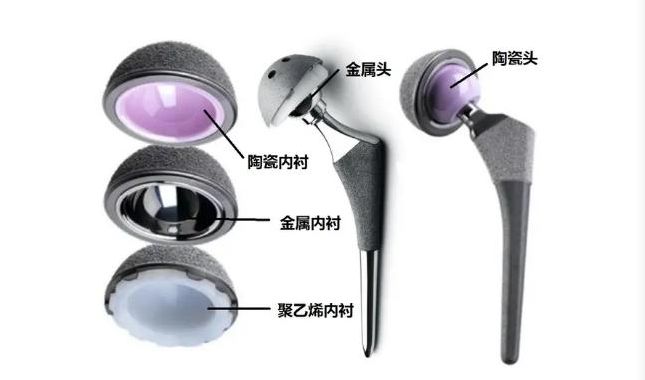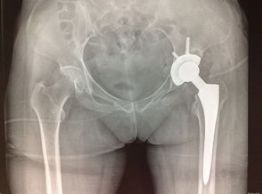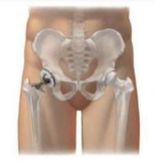ბარძაყის სახსრის ენდოპროთეზირება უკეთესი ქირურგიული პროცედურაა ბარძაყის თავის ნეკროზის, ბარძაყის სახსრის ოსტეოართრიტის და მოტეხილობების სამკურნალოდ.ბარძაყისკისერი ხანდაზმულ ასაკში. მენჯ-ბარძაყის სახსრის ენდოპროთეზირება ამჟამად უფრო მოწიფული პროცედურაა, რომელიც თანდათან იძენს პოპულარობას და მისი შესრულება შესაძლებელია ზოგიერთ სოფლის საავადმყოფოშიც კი. მენჯ-ბარძაყის სახსრის ენდოპროთეზირების მქონე პაციენტების რაოდენობის ზრდასთან ერთად, პაციენტები ხშირად შეშფოთებულნი არიან, თუ რამდენ ხანს გაძლებს პროთეზი მენჯ-ბარძაყის სახსრის ენდოპროთეზირების ოპერაციის შემდეგ და გაძლებს თუ არა ის მთელი ცხოვრება. სინამდვილეში, რამდენ ხანს შეიძლება მენჯ-ბარძაყის სახსრის ენდოპროთეზირება ოპერაციის შემდეგ, დამოკიდებულია სამ მთავარ ასპექტზე: 1. მასალების არჩევანი: ამჟამად ხელოვნური მენჯ-ბარძაყის სახსრისთვის სამი ძირითადი მასალა არსებობს: 1. კერამიკული თავი + კერამიკული ჭიქა: ღირებულება შედარებით მაღალი იქნება. ამ კომბინაციის მთავარი უპირატესობა ის არის, რომ ის შედარებით უფრო ცვეთამედეგია. კერამიკულ და კერამიკულ ხახუნის შემთხვევაში, იგივე დატვირთვა, ლითონის საფართან შედარებით ცვეთა გაცილებით მცირეა და სახსრის ღრუში ცვეთის გამო დარჩენილი პაწაწინა ნაწილაკებიც ძალიან მცირეა, ძირითადად, არ იქნება სხეულის რეაქცია ცვეთის ნაწილაკებზე. თუმცა, დაძაბული აქტივობის ან არასწორი პოზის შემთხვევაში, კერამიკის გახეთქვის ძალიან მცირე რისკია. ასევე ძალიან ცოტა პაციენტია, რომელიც აქტივობის დროს განიცდის კერამიკული ხახუნით გამოწვეულ „ჭრიალის“ ხმას.
2. ლითონის თავი + პოლიეთილენის ჭიქა: გამოყენების ისტორია უფრო ხანგრძლივია და უფრო კლასიკური კომბინაციაა. ლითონისა და ულტრა მაღალი პოლიმერული პოლიეთილენის კომბინაცია, როგორც წესი, არ ვლინდება აქტივობაში, აქვს უჩვეულო ჭრიალი და არ ზიანდება. თუმცა, კერამიკულ-კერამიკულ ხახუნის ზედაპირთან შედარებით, ის შედარებით უფრო მეტად ცვდება იმავე დატვირთვის ქვეშ იმავე დროის განმავლობაში. მგრძნობიარე პაციენტების ძალიან მცირე რაოდენობაში ის რეაგირებს ცვეთის ნამსხვრევებზე, რაც საპასუხოდ იწვევს ცვეთის ნარჩენების გარშემო ანთებას და თანდათანობით ტკივილს პროთეზის გარშემო, პროთეზის მოდუნებას და ა.შ. 3. ლითონის თავი + ლითონის ბუში: ლითონ-ლითონ ხახუნის ზედაპირს (კობალტ-ქრომის შენადნობი, ზოგჯერ უჟანგავი ფოლადი). ეს ხახუნის ზედაპირს 1960-იან წლებში იყენებდნენ. თუმცა, ამ ზედაპირს შეუძლია წარმოქმნას ლითონის ცვეთის ნაწილაკების დიდი რაოდენობა, ამ ნაწილაკების ფაგოციტოზი შესაძლებელია მაკროფაგების მიერ, რაც იწვევს უცხო სხეულის რეაქციას. ცვეთის შედეგად წარმოქმნილი ლითონის იონები ასევე შეიძლება შევიდნენ სისხლში, რაც იწვევს ალერგიულ რეაქციას ორგანიზმში. ბოლო წლებში, ამ ტიპის ზედაპირული სახსრების წარმოება შეწყდა. ④ კერამიკული თავი პოლიეთილენზე: კერამიკული თავები უფრო მყარია, ვიდრე ლითონი და წარმოადგენს იმპლანტის ყველაზე ნაკაწრებისადმი მდგრად მასალას. სახსრების ჩანაცვლების ქირურგიაში ამჟამად გამოყენებულ კერამიკას აქვს მყარი, ნაკაწრებისადმი მდგრადი, ულტრაგლუვი ზედაპირი, რომელსაც შეუძლია მნიშვნელოვნად შეამციროს პოლიეთილენის ხახუნის ინტერფეისების ცვეთის სიჩქარე. ამ იმპლანტის პოტენციური ცვეთის სიჩქარე ნაკლებია, ვიდრე ლითონ-პოლიეთილენის, სხვა სიტყვებით რომ ვთქვათ, კერამიკა-პოლიეთილენის თეორიულად უფრო ცვეთისადმი მდგრადია, ვიდრე ლითონ-პოლიეთილენის! ამიტომ, საუკეთესო ხელოვნური ბარძაყის სახსარი, მხოლოდ მასალის თვალსაზრისით, არის კერამიკულ-კერამიკული ინტერფეისული სახსარი. ამ სახსრის ხანგრძლივი მომსახურების მიზეზი ის არის, რომ ცვეთის სიჩქარე ათობითჯერ ან ასჯერ მცირდება წინა სახსრებთან შედარებით, რაც მნიშვნელოვნად ახანგრძლივებს სახსრის გამოყენების დროს, ხოლო ცვეთის ნაწილაკები არის ადამიანისთვის თავსებადი მინერალები, რომლებიც არ იწვევენ ოსტეოლიზს და ოსტეოპოროზს პროთეზის გარშემო, რაც უფრო შესაფერისია მაღალი აქტივობის მქონე ახალგაზრდა პაციენტებისთვის. 2. ბარძაყის პროთეზის ზუსტი განთავსება: ოპერაციის დროს პროთეზის ზუსტი განთავსების წყალობით, აცეტაბულუმი და ბარძაყის ღერო. პროთეზის მყარი ფიქსაცია და შესაბამისი კუთხე ხელს უშლის პროთეზის კონცენტრაციას და დისლოკაციას, რითაც არ იწვევს პროთეზის მოდუნებას.
საკუთარი ბარძაყის სახსრის დაცვა: პროთეზის ცვეთის შესამცირებლად შეამცირეთ წონის ტარება, დატვირთული აქტივობები (მაგალითად, ცოცვა და დიდი ხნის განმავლობაში წონის ტარება და ა.შ.). გარდა ამისა, თავიდან აიცილეთ დაზიანებები, რადგან ტრავმამ შეიძლება გამოიწვიოს ბარძაყის პროთეზის გარშემო მოტეხილობები, რამაც შეიძლება გამოიწვიოს პროთეზის მოდუნება.
ამიტომ, ნაკლებად აბრაზიული მასალებისგან დამზადებული ბარძაყის პროთეზები, ზუსტი განთავსებაბარძაყის სახსარიხოლო მენჯ-ბარძაყის სახსრის აუცილებელმა დაცვამ შეიძლება პროთეზი უფრო დიდხანს გაძლოს, თუნდაც მთელი სიცოცხლის განმავლობაში.
გამოქვეყნების დრო: 2023 წლის 11 იანვარი














